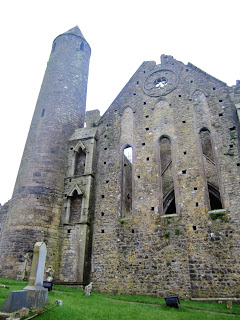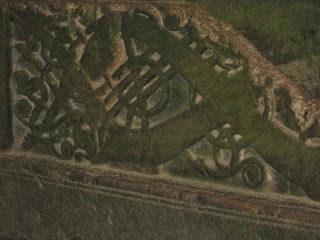The
cake I was baking whilst writing part one of this post turned out wonderfully.
Now I am taking full advantage of my kitchen to bake oatmeal bread, so yet
again I have an hour to kill while my dough rises.
 |
| This is the cake. 'Twas a good cake. Also my pretty roommates. |
I
believe I left off as we were leaving the historical wonderment of Cahir
castle.
We
went for lunch at an adorable café-lunchroom-type-establishment literally
across the road from the castle- this is unimportant, but I wanted to qualify
the panini mentioned last time (query: Microsoft Word wants me to capitalize
“Panini.” See, it just made it capitalized there! Is there an Italian city,
town, or principality called Panini? Even more importantly, do they have
excellent grilled sandwiches there? I shall investigate). After lunch, we
hopped back on the bus and headed to Cashel.
The
rock of Cashel is not, in fact, a rock. I suppose it is a rock in the purest
sense, seeing as it sits atop a large escarpment in the middle of the
countryside, but it is not the rock that causes tourists to flock to Cashel. Having
done uncharacteristically little research on the rock, I was imagining it to be
a large monolithic granite thing in the middle of a field. I was shocked and
awed, then, to see this upon our arrival in the town of- you guessed it-
Cashel:
 |
| that is not a rock |
It’s
a massive castle-cathedral that was once the seat of the king of Munster,
Cormac McCarthy (not the author of “The Road-” a slightly older Cormac
McCarthy, who also spelled his name Mac Carthaigh). The massive structure houses
centuries of amazing artwork, including everything from beautiful frescoes to
an ancient Cross of Saint Patrick to one gnarly sarcophagus. I should like to
be buried in such a sarcophagus.
 |
| Tapestries too! |
 |
| #fresco obsession |
 |
| Add caption |
 |
| Detail of my new favorite sarcophagus |
This
being a field trip, we had a tour guide. I have dubbed him Ronan the
Controversial. I, for one, thought that Ronan (the Controversial) did an
amazing job of explaining the complexities of Cashel’s history, although
deathly boring, mean, prickly, standoffish, cold, and many worse adjectives
were all thrown around by others on the tour. Ronan the Controversial had the
most beautiful elocution I have ever heard. His spiel was like a Keats ode performed
by Edwin Booth and incredibly smooth. It was as if he were reading from a
well-written guidebook, not off-the-cuff lecturing, and I probably missed a
good third of what he said trying to figure out just how he carried on so. If I
could mellifluously declaim in such a manner, I would often and loudly.
If
any of my charming readers come to visit me in Ireland, we are going to Cashel
and requesting a tour from Ronan. It is not negotiable.
 |
| It seems that Ronan the Controversial tour guide has snuck into the corner of this photograph |
Anyways,
here are a series of awesome, austere pictures from Cashel. Its cathedral wing
(built in the 12th and 13th centuries, dontcha know) has
been surrounded by an imposing lattice of rebar and steel that supports an
artificial roof designed to keep the creeping damps out, but really just makes
one whole half of Cashel look like a futuristic dystopian industrial build-site
of abandonment.
I
like the juxtaposition of old and new rather a lot.
Cashel
also has a beautiful cemetery knee-deep in Celtic crosses. It affords an
amazing panorama of the surrounding countryside. We got to watch a rainstorm
roll in from the South, and it was positively gorgeous.
I
probably should have thought of a more appropriate phrase up there, as “positively
gorgeous” is painfully generic, but my bread is all baked and I have some
reading to do. I shall, then, make it brief.
After
adventuring around the Rock for a while and jumping off of rocky outcroppings
and/or ancient well bases, we piled back onto the bus and made a little trip to
the Swiss Cottage. This is a lovely building that is both Swiss-looking and a
cottage. Just like it says on the package.
 |
| The river Suir, pronunciation questionable |
It
is where the great and powerful Butler family- or, alternately, the mistress of
a Butler patriarch- had a retreat back in the hills on the banks of the river
Suir. It is lovely, but was closed off for the day by the time we arrived. Hence,
our group took turns skulking around the spike-tipped fence surrounding the
house, snapping pictures and looking innocent.
Then
I took a very blurry picture of a white duck. It was a nice picture, but I have misplaced it.
Alas.
The
drive home was rainy and peaceful as could be. I was frittered from a long day
of gallivanting about the countryside, and was lulled to sleep by Liam the bus
driver’s singing for us a selection of ballads and rousing drinking songs. My favorite
was one simply titled “A Father’s Lament,” incredibly sad and about a father
travelling to Dublin to claim his son’s body after the Easter Rising (or was it
the Civil War of the ‘20s? Just know that Ireland’s history is full to bursting
with sad tales of massacres, bombs, battles, and riots). At any rate, Liam’s
sang us all the way back to Leeside (encouraging group participation on those
songs we know by heart such as “Star of the County Down” and the Irish national
anthem… except this last was in Irish, so nobody was able to keep pace).
Before
my bread burns, I will conclude by giving five solid, shiny gold stars to Cahir
and Cashel.
Until
next time!






























